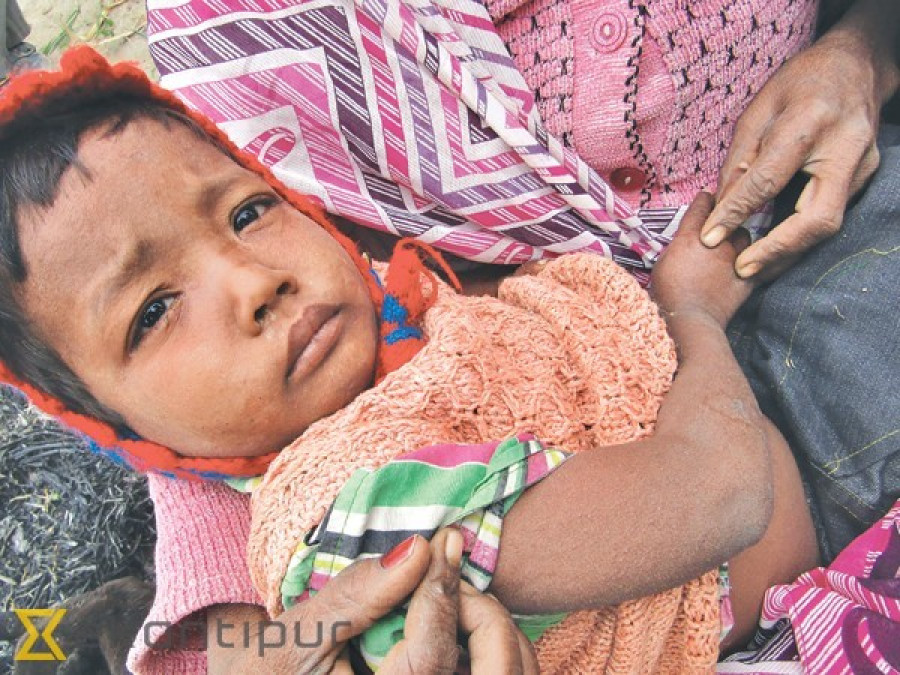National
Low vaccine coverage rate, floating population leading to repeat measles outbreaks
Most of the measles outbreak cases in the district take place in Muslim and backward communities where the level of awareness about the importance of regular immunisation is very low.
Arjun Poudel
Phanindra Nath Tiwari, a health worker serving at the Province 5 Health Office in Kapilvastu, has his plate full. Alongside his job as a health worker, he is also tasked with carrying out managerial works of immunisation programme as the office has been without immunisation supervisor for the last two years.
The Ministry of Health and Population is yet to send an immunisation supervisor to the office to replace the previous supervisor who was transferred two years ago.
The immunisation programme has been affected in the absence of supervising officer.
Besides supervising officer, Tiwari said, the ministry has also not sent replacements for the retired and tansferred staff.
Kapilvastu witnesses measles outbreak every year. But the health authority is struggling to stop the outbreaks in the absence of immunisation programme supervisor and other officers.
Tiwari said the immunisation programme has also been affected due to lack of awareness among the people.
Most of the measles outbreak cases in the district take place in Muslim and backward communities where the level of awareness about the importance of regular immunisation is very low.
“There are rumours among these communities that measles vaccine causes impotence and they can cause high fever. This has also contributed to low vaccination coverage rate,” Tiwari said.
The then District Public Health Office, which was changed into Provincial Health Office, has been unable to operate immunisation booths in several remote villages in areas that share border with India due to lack of immunisation staff and awareness among the public.
Until three years ago, the then District Public Health Office used to operate immunisation booths and launch regular awareness drives to boost the vaccination coverage rate.
The overall coverage rate of measles vaccine in the district stands at about 57 percent, while other districts throughout the country have over 80 percent coverage.
Health workers said that vaccine officers also avoid going to the bordering areas to immunise the children due to security reasons.
“Neither the federal nor the provincial governments are concerned about such ground level problems,” a health worker told the Post.
Gyan Bahadur BC, chief of the Provincial Health Office in Morang of Province 1, said that his office does not even have the exact data of children in the district.
“People living in the bordering areas regularly move in and out of the district making it difficult for the office to keep an updated data,” said BC. “Some people go to India and return with infection further spreading the disease in their villages.”
Dang was declared fully immunised district some two years ago. But recently, several children in Ward 4 of Rajpur Rural Municipality have been found infected with measles.
Morang, Dang and Kapilvastu districts witnessed measles outbreak in April.
Health workers believe that Dang’s close proximity to Kapilvastu and Rupandehi districts, which have low vaccine coverage rates, might have lead to the spread.
Measles is a contagious viral disease transmitted through fluids from nose, mouth or throat of infected persons.
Low vaccination coverage, floating population, lack of public awareness about the importance of vaccines and apathy on the part of concerned government agencies are some of the reasons behind regular outbreaks of measles in different parts of the district, according to health experts.
Measles was endemic in Nepal and on an average 90,000 cases were recorded every year from 1994 to 2004. The government launched routine measles vaccination programme in the country from late 1980s. Still, measles continue to stalk many children across the country.
Nepal had committed to eliminating measles within 2019. However, looking at the frequent occurrence of measles cases, officials say, the country may miss the goal.
To declare measles as eliminated, the number of cases should be less than five in every 1,000,000 population or no cases throughout the year.




 20.12°C Kathmandu
20.12°C Kathmandu















